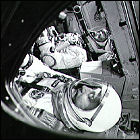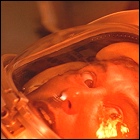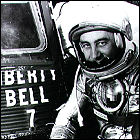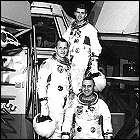Chariots For Apollo

 Story: Long before men set foot on the moon or even set off on a journey to orbit it, NASA engineers and their brethren at several corporate contractors and subcontractors sweated blood to make sure that the astronauts would have spaceworthy vehicles to fly. Veteran aviation and theoretical engineers alike gave up family life, personal time, and other amenities because they faced the reality that, if their numbers were even slightly off, astronauts could die. Some of them watched their worst nightmares realized when Gus Grissom, Ed White and Roger Chaffee died on the ground in the Apollo 1 fire. But they still kept up an unrelenting quest to get the numbers right and put Americans on the moon by the end of the sixties.
Story: Long before men set foot on the moon or even set off on a journey to orbit it, NASA engineers and their brethren at several corporate contractors and subcontractors sweated blood to make sure that the astronauts would have spaceworthy vehicles to fly. Veteran aviation and theoretical engineers alike gave up family life, personal time, and other amenities because they faced the reality that, if their numbers were even slightly off, astronauts could die. Some of them watched their worst nightmares realized when Gus Grissom, Ed White and Roger Chaffee died on the ground in the Apollo 1 fire. But they still kept up an unrelenting quest to get the numbers right and put Americans on the moon by the end of the sixties.
Review: A bit of a “tech novel” of sorts, Chariots For Apollo does not assume that anyone opening the book’s cover understands all of the terminology involved in going to the moon, let alone the math, but it does an admirable job of catching you up very quickly.
But that’s not the heart of this book.
Behind the tech talk, Chariots For Apollo is about the people who dreamed, and then built, the Apollo program (primarily the delicate lunar excursion module).
The longest-serving astronaut retires
 A veteran of the Gemini, Apollo and shuttle programs, 74-year-old astronaut John Young retires from NASA, capping off a 42-year career with the space agency. Young joined NASA in 1962 after hearing President Kennedy’s historic directive to launch a manned mission to the moon, and only three years later Young flew with Mercury veteran Gus Grissom on Gemini 3, the first manned two-person NASA mission. Young commanded Gemini 10 in 1966, was the command module pilot for the moon-orbiting Apollo 10 mission, and in 1972, Young commanded Apollo 16, landing in the moon’s mountainous Descartes region. Young commanded the first space shuttle mission, the maiden flight of Columbia in 1981, and commanded the ninth shuttle flight in 1983. Young had also served as the Chief Astronaut, determining crew assignments and making personnel decisions. In the wake of the Challenger disaster in 1986, Young became one of NASA’s most outspoken critics, and was reassigned to the position of special assistant for engineering, operations and safety – a move he regarded as a political one.
A veteran of the Gemini, Apollo and shuttle programs, 74-year-old astronaut John Young retires from NASA, capping off a 42-year career with the space agency. Young joined NASA in 1962 after hearing President Kennedy’s historic directive to launch a manned mission to the moon, and only three years later Young flew with Mercury veteran Gus Grissom on Gemini 3, the first manned two-person NASA mission. Young commanded Gemini 10 in 1966, was the command module pilot for the moon-orbiting Apollo 10 mission, and in 1972, Young commanded Apollo 16, landing in the moon’s mountainous Descartes region. Young commanded the first space shuttle mission, the maiden flight of Columbia in 1981, and commanded the ninth shuttle flight in 1983. Young had also served as the Chief Astronaut, determining crew assignments and making personnel decisions. In the wake of the Challenger disaster in 1986, Young became one of NASA’s most outspoken critics, and was reassigned to the position of special assistant for engineering, operations and safety – a move he regarded as a political one.
The raising of Liberty Bell 7
 A day short of exactly 38 years since the capsule flew its suborbital flight and then sank as it took on water upon splashdown, Liberty Bell 7, the Mercury capsule flown by Gus Grissom in 1961, is raised from the floor of the Atlantic Ocean from a depth of almost 16,000 feet. The recovery, requiring specialized deep sea equipment, is bankrolled by the Discovery Channel, which gains exclusive broadcast rights to the event. The capsule itself is cleaned up, restored, and put on display at the Kansas Cosmosphere space museum in Hutchinson, Kansas.
A day short of exactly 38 years since the capsule flew its suborbital flight and then sank as it took on water upon splashdown, Liberty Bell 7, the Mercury capsule flown by Gus Grissom in 1961, is raised from the floor of the Atlantic Ocean from a depth of almost 16,000 feet. The recovery, requiring specialized deep sea equipment, is bankrolled by the Discovery Channel, which gains exclusive broadcast rights to the event. The capsule itself is cleaned up, restored, and put on display at the Kansas Cosmosphere space museum in Hutchinson, Kansas.
From The Earth To The Moon: Night 1
 Pay cable channel HBO premieres its heavily-promoted docudrama miniseries From The Earth To The Moon, executive produced by actor Tom Hanks (Apollo 13) through Ron Howard’s Imagine Films. The series chronicles NASA’s quest to reach the moon, and two episodes debut each Sunday of the show’s run. The first night covers Sputnik through the Gemini program in the episode Can We Do This?, and then devotes a full hour to the Apollo One fire and its aftermath. Nick Searcy stars as Deke Slayton, with Mark Rolston as Gus Grissom, musician/actor Chris Isaak as Ed White, and David Andrews as Frank Borman. Kevin Spacey, Mason Adams and John Slattery (Mad Men) guest star.
Pay cable channel HBO premieres its heavily-promoted docudrama miniseries From The Earth To The Moon, executive produced by actor Tom Hanks (Apollo 13) through Ron Howard’s Imagine Films. The series chronicles NASA’s quest to reach the moon, and two episodes debut each Sunday of the show’s run. The first night covers Sputnik through the Gemini program in the episode Can We Do This?, and then devotes a full hour to the Apollo One fire and its aftermath. Nick Searcy stars as Deke Slayton, with Mark Rolston as Gus Grissom, musician/actor Chris Isaak as Ed White, and David Andrews as Frank Borman. Kevin Spacey, Mason Adams and John Slattery (Mad Men) guest star.
More about From The Earth To The Moon in the LogBook
From The Earth To The Moon now streaming on HBO Max
Gemini 3
 The first two-man American space crew lifts off in the first manned flight of NASA’s Gemini program. With a larger, more maneuverable spacecraft designed for longer stays in space, Gemini is intended to be a stepping stone on the path to the first lunar landing, allowing astronauts to practice rendezvous, docking, and orbital changes. Aboard the Gemini capsule are Mercury veteran Gus Grissom and rookie John Young; the capsule is unofficially nicknamed “Molly Brown” (a reference to Grissom’s sunken Mercury capsule). The flight lasts barely five hours and includes the first-ever orbital attitude changed made by a manned spacecraft.
The first two-man American space crew lifts off in the first manned flight of NASA’s Gemini program. With a larger, more maneuverable spacecraft designed for longer stays in space, Gemini is intended to be a stepping stone on the path to the first lunar landing, allowing astronauts to practice rendezvous, docking, and orbital changes. Aboard the Gemini capsule are Mercury veteran Gus Grissom and rookie John Young; the capsule is unofficially nicknamed “Molly Brown” (a reference to Grissom’s sunken Mercury capsule). The flight lasts barely five hours and includes the first-ever orbital attitude changed made by a manned spacecraft.
Mercury 4: a sinking feeling
 The second American in space is Virgil “Gus” Grissom, pilot of the Mercury 4 capsule Liberty Bell 7. Like Alan Shepard’s flight, Grissom’s launch reaches an altitute of 118 miles and splashes down 15 minutes later, but mechanical problems with the explosive bolts to release the capsule’s hatch allow water into the vehicle. Grissom has to bail out at sea, wearing a spacesuit that’s rapidly taking on water, while Liberty Bell 7 sinks to the bottom of the Atlantic. Grissom weathers repeated accusations that he manually blew the hatch and caused his vehicle to sink, a claim which is later disproven.
The second American in space is Virgil “Gus” Grissom, pilot of the Mercury 4 capsule Liberty Bell 7. Like Alan Shepard’s flight, Grissom’s launch reaches an altitute of 118 miles and splashes down 15 minutes later, but mechanical problems with the explosive bolts to release the capsule’s hatch allow water into the vehicle. Grissom has to bail out at sea, wearing a spacesuit that’s rapidly taking on water, while Liberty Bell 7 sinks to the bottom of the Atlantic. Grissom weathers repeated accusations that he manually blew the hatch and caused his vehicle to sink, a claim which is later disproven.
Apollo 1
 During a ground test of the Apollo 1 spacecraft, a fire breaks out in the 100% oxygen atmosphere of the Apollo capsule, leaving the crew – Virgil “Gus” Grissom, Ed White and Roger Chaffee – unable to operate or open the hatch. The searing heat burns through their oxygen hoses, suffocating the three astronauts in short order. Months of investigations and accusations follow, leading to changes of management at both NASA and North American Aviation, the aerospace company contracted to build the Apollo command/service module. Extensive redesign of the Apollo vehicle follows, including a switch to a nitrogen/oxygen atmosphere and a complete rethink of the hatch, and manned flights won’t resume until late 1968.
During a ground test of the Apollo 1 spacecraft, a fire breaks out in the 100% oxygen atmosphere of the Apollo capsule, leaving the crew – Virgil “Gus” Grissom, Ed White and Roger Chaffee – unable to operate or open the hatch. The searing heat burns through their oxygen hoses, suffocating the three astronauts in short order. Months of investigations and accusations follow, leading to changes of management at both NASA and North American Aviation, the aerospace company contracted to build the Apollo command/service module. Extensive redesign of the Apollo vehicle follows, including a switch to a nitrogen/oxygen atmosphere and a complete rethink of the hatch, and manned flights won’t resume until late 1968.
This event is dramatized in the Apollo One episode of HBO’s 1998 series From The Earth To The Moon.